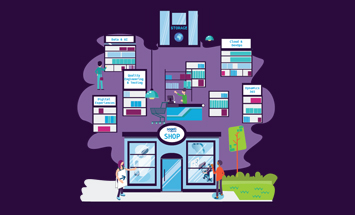Sustainability by Design: A Paradigm Shift in IT Projects
Jonas Hultenius, Software Architecht at Sogeti and one of our global experts in SogetiLabs writes about sustainability in this blog. Read it to find out more about hos sustainability is emerging as a key deliverable, that must be integrated from the onset of every IT endeavor.
Sustainability is quickly, and finally, becoming more and more into style and in an era where the impact of technology on the environment is under increasing scrutiny, the concept of sustainability has transcended its role as a buzzword. It has evolved into a fundamental consideration, demanding a paradigm shift in how we approach and execute IT projects. Sustainability, once an afterthought, is now emerging as a key deliverable that must be integrated from the onset of every IT endeavor.
The environmental consequences of IT activities, from data centers to software development, are no longer ignorable footnotes. The carbon footprint of the tech industry is significant, and as society becomes more environmentally conscious, businesses and individuals are compelled to reevaluate their digital practices. Sustainable IT is not just a moral imperative, it's a strategic necessity.
Traditionally, sustainability considerations were often completely overlooked or tacked on at the end of a project, treated as a checkbox in the final stages of development. However, this approach is no longer tenable. The ethos of sustainability must be ingrained in the very fabric of IT projects, influencing decisions from conception to deployment. It's not just about mitigating negative impacts; it's about creating positive ones.
Over the next coming years, it is imperative that we stop treating it as an afterthought and switch mindset to seeing it as a forethought. It should permeate all aspects of the development process from the first drafts and idea stage to the implementation and later on release and maintenance of the product.
Embracing sustainability from the outset requires a shift in our normal mode of operation, and design thinking provides a fitting framework. Design thinking, with its emphasis on empathy, ideation, and iteration, aligns perfectly with the goals of sustainable IT. It encourages a holistic view, prompting project teams to consider the social, economic, and environmental implications of their work.
The foundation of sustainable IT lies in the infrastructure that supports it. From the data centers that power our digital world to the devices we use daily, a commitment to renewable energy and energy efficiency is paramount. This includes exploring alternative energy sources, optimizing hardware design for energy efficiency, and adopting circular economy principles to reduce electronic waste.
Software development is a significant contributor to the carbon footprint of the IT industry. Sustainable coding practices involve writing code that is not only efficient in terms of execution but also environmentally friendly. This may involve optimizing algorithms, reducing redundant processes, and minimizing resource consumption.
Tools and frameworks that facilitate green coding practices are gaining traction after being largely ignored for years and some of the gains can be achieved quickly and easily and for cents on the dollar. It turns out that better code for the climate often tends to be quicker for the end user and less resource heavy leaving us with more resources and less of a need to shell out for more. So, being green gives us more green (in our wallets).
Sustainability isn't just about how a system operates, it's also about its entire lifecycle. From the extraction of raw materials for hardware to the disposal of obsolete devices, every phase must be managed sustainably. This involves responsible sourcing of materials, designing for longevity and recyclability, and implementing effective end-of-life strategies.
On often overlooked aspect is that Sustainable IT is not solely about environmental impact, it extends to the social dimension as well. Ethical considerations, such as ensuring fair labor practices in the supply chain and promoting inclusivity in technology access, are integral to a comprehensive sustainability strategy. Social responsibility is an intrinsic part of the broader sustainability narrative.
We have a chance to do a spring cleaning of the whole tech sector and I for one hope that this equally important aspect gets more traction.
Quantifying sustainability is a challenge but a necessary one. Metrics that capture energy consumption, emissions, and resource utilization provide a basis for assessing the environmental impact of IT projects. Establishing key performance indicators (KPIs) for sustainability allows organizations to track progress and continually improve their practices.
As awareness of environmental issues grows, regulatory bodies are increasingly scrutinizing the sustainability practices of organizations. Compliance with environmental standards and regulations is becoming a prerequisite for doing business. Proactively adopting sustainable practices not only aligns with regulatory expectations but positions organizations as leaders in responsible corporate citizenship.
I have foreseen for some time that sustainability will be a sought-after commodity ion both the public and private sector as governments and other businesses sees the importance and benefits these transformations holds. And largely this prediction has started to take shape.
So, beyond meeting regulatory requirements, there is now a compelling business case for sustainability. Consumers are becoming more discerning, preferring products and services from environmentally conscious providers. And as such more and more companies will adapt to this change in end user preferences.
Adopting sustainable practices can also enhance brand reputation, attract environmentally conscious customers and equally important well as conscious employees. More and more of the workforce is not inclined to work for a company that they don’t feel share their values. So, adopting sustainability is a key factor in being an attractive employer.
And that is just the softer, more human, aspects of the business case. Sustainability practices will result in cost savings through energy efficiency measures and with the fluctuations in the energy market this is in itself a selling point to most companies.
This is all well and good but how do we get there?
Implementing sustainability by design requires a collective effort. Education is key, ensuring that all stakeholders, from project managers to developers, understand the importance of sustainable practices.
Collaboration between industry, academia, and policymakers is crucial to developing and disseminating best practices that contribute to a more sustainable IT ecosystem on a larger or even global scale. But on a company level it is about educating all stakeholders and contributors about the benefits and practices that exist today and how we can leverage these methods and techniques in our day-to-day operation.
Sustainability by design is not a destination but a journey. It requires ongoing commitment, adaptation to emerging technologies, and a willingness to embrace innovative solutions. As IT professionals, we are not just architects of digital solutions; we are stewards of the environment. By integrating sustainability into the DNA of IT projects, we can contribute to a more resilient and responsible digital future.
- Jonas HulteniusSoftware Architect & SogetiLabs Fellow, Sogeti Sweden
070-518 66 25
 Jonas HulteniusSoftware Architect & SogetiLabs Fellow, Sogeti Sweden
Jonas HulteniusSoftware Architect & SogetiLabs Fellow, Sogeti Sweden
070-518 66 25






